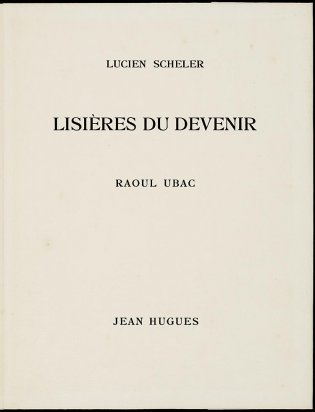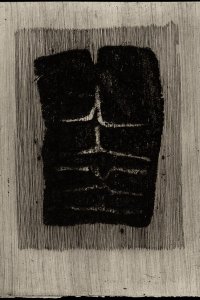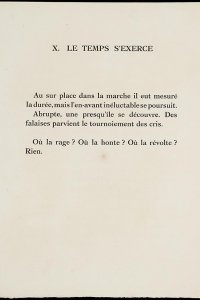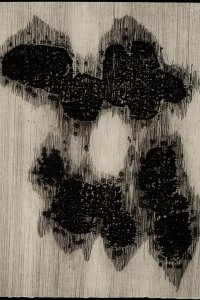Lisières du devenir : poème
Année: 1963
Auteur: Lucien Scheler (1902 - 1999)
Artiste: Raoul Ubac (1910 - 1985)
Éditeur: Jean Hugues
Lisières du devenir : poème, page de titre
Thanks to the artistic circles that his mother was active in, Lucien Scheler came into contact with painters from an early age. Between age twenty and thirty, he lived at Montparnasse. He wanted to be a writer and painter, but eventually chose to be a publisher, bookseller and editor. At Gallimard, he among others edited the Oeuvres complètes of Rabelais and Éluard for the Pléiade edition.
The art of Raoul Ubac
Together with the artist Raoul Ubac, Scheler produced a number of livres d'artiste. With Ubac he shared a lively interest in poetry and philosophy, and it was Ubac who illustrated Scheler's first book, La lampe tempête, in 1946. Until the war, Ubac was active in the Surrealist movement as a photographer. He was especially attracted to the rebellious atmosphere. Scheler, for that matter, had no affinity with Surrealism; he could not bear the 'obscene expressions' of the surrealists. On the other hand, he did like the poems by Aragon and Éluard. After the war Ubacs ties to the surrealists disintegrated, and he left photography behind in orde to draw, paint, and especially etch. According to Ubac, the working of materials (stone, wood or copper) was the essence of art. In order to bring the work of art to life, the subjective, the personal had to make way for the work of art itself.
Time in seventeen prose poems
In 1963, almost twenty years after the publication of their first artist's book, Ubac and Scheler produced their second and last work: Lisières du devenir. In seventeen prose poems Scheler reflected on the properties of time and the temporariness of existence; seasons, the landscape. They sketch the ruthless progress of Time. For example, in poem X:
Où la rage? Où la honte? Où la révolte?
Rien
[Where is the rage? Where is the shame? Where is the revolt? Nothing.]
Ubac illustrated Scheler's thoughts by means of six sober etchings in black, white and grey. The three colours are so subtly nuanced that the illustrations resemble fossils or ancient rock formations that slowly crumble away. Therefore Ubac's etchings go very well with Scheler's pitchblack text, printed in a large type face.
-
Lucien Scheler, Lisières du devenir (1963), frontispice: ets door Raoul Ubac
-
Lucien Scheler, Lisières du devenir (1963), gedicht X
-
Lucien Scheler, Lisières du devenir (1963), ets door Raoul Ubac bij gedicht X
Lucien Scheler, Lisières du devenir (1963): colophon
Publisher Jean Hugues
According to the publisher Jean Hugues, Lisières du devenir was a friends' album; it mirrored the intimate friendship between Scheler and himself, and a life devoted to books. Both men were publishers and booksellers. It was not without reason that Hugues' famous gallery Le Point Cardinal, founded in 1961, was the meeting place for artists such as Giacometti and Ernst. Lisières du devenir clearly shows Hugues' vision of the artist's book: a livre d'artiste should be rigourous, classical and minimalist
Bibliographical description
Description: Lisières du devenir : poème / Lucien Scheler ; ill. de gravures sur cuivre par Raoul Ubac. - Paris: Jean Hugues, 1963. - [40] p. : ill. ; 32 cm
Printer: Union (Paris) (typography) ; Lacourière et Frélaut (copper plates)
Edition: 90 copies
This copy: Number 49 of 90 on Auvergne paper Richard de Bas. Signed by the author and artist. Initialled by the publisher
Bibliography: Bénézit 13-883 ; Hogben 161; Johnson 31-508; Monod 10201; Strachan 218
Shelfmark: KW KOOPM K 310
References
- Antoine Coron, Scheler (Lucien). Bruxelles, Bibliotheca Wittockiana, 1987
- Diane Hennebert, Raoul Ubac: photographies, peintures, sculptures, dessins et gravures. Bruxelles, Les Editions du Botanique, 1987
- André Jammes,Jean Hugues libraire-éditeur: Le Point Cardinal. Paris, Editions des Cendres, 2004




